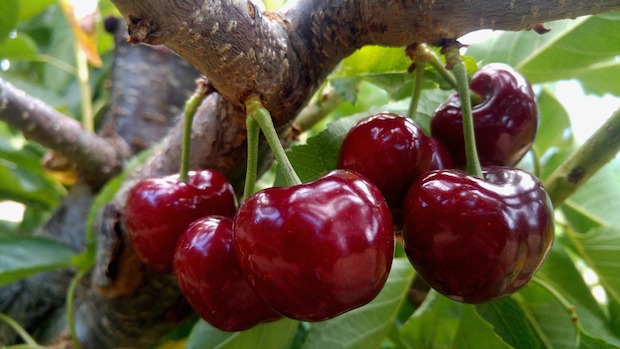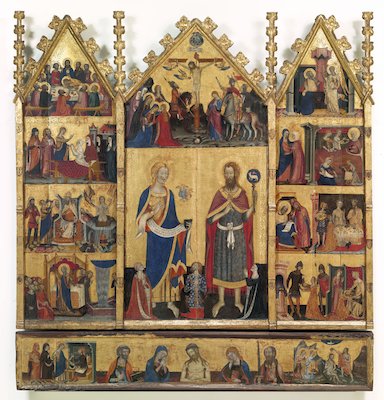Pablo José Alcover Cateura and Antoni Riera Melis

Introduction
Cherries are depicted in two Gothic altarpieces in the Museu Nacional d’Art de Catalunya. This entry in the museum’s blog will explain why they are there.
First, a few notes about the word ‘cherry’. The English word, the Catalan cirera and the Castilian cereza all come from the Vulgar Latin ceresĭa. The Latin word comes from κέρᾰσος, an ancient Greek word. The Greek word has even older precedents. Researchers are still arguing about this more archaic origin, whether it is Akkadian, Phoenician or Armenian. But in general they all agree that it is one of the oldest types of food eaten by humans and that it came originally from the Near East.
The cherry tree has been cultivated since the Neolithic period. It might possibly have arrived in the western Mediterranean from Asia Minor. Pliny the Elder claims that it was introduced by the Roman consul Lucius Licinius Lucullus, who discovered it in the kingdom of Pontus (Black Sea) in about 150 BC, during the war against Mithridates IV. Other sources claim that the cherry tree had already been introduced to the Italian peninsula, at least three centuries before the Black Sea campaign. Lucullus is only credited with the introduction of a variety of cherries bigger and sweeter than those that were known then. Whatever the truth of the matter, since Antiquity, cherries have become a much appreciated and well-known fruit, eaten widely.
In the Middle Ages, the word cherry referred to the fruit of different species of trees of the genus Prunus. A limited number of species of Prunus were used for human consumption. The varieties of cherry trees whose fruit was eaten were those that bore the sweetest fruit.
Cherries were not just appreciated for their taste but also for their colour, which varied from very dark red to light yellow. The colour preferred by people in the Middle Ages was the one we still prefer today: red. We now know that the varieties of red cherries are also an excellent source of phenolic antioxidants.
Cherries were eaten fresh and preserved (with honey or sugar). We shall focus on the fresh ones.

Fresh cherries were a usual sight on tables, especially those of the highest social classes. The poorest people did not have access to this fruit. It was very popular with the inhabitants of the Crown of Aragon in the 14th and 15th centuries, so much so that within the gift-giving culture of the period, cherries were considered to be a good present. At banquets it was normal to serve them in a receptacle with other kinds of seasonal fruit or to scatter them around the table. There were some special meals, such as at weddings, where it was the custom to scatter pairs of them on the tablecloth.
The cherry trees bearing the sweetest varieties blossomed in April, and between May and June they bore fruit, depending on the variety and the area. Thus, the best time to eat cherries was the same as it is now. Popular wisdom remembers this in a saying: “Les cireres, d’una a una pel maig, i pel juny, a grapades” (Eat cherries one by one in May, and in bunches in June).
A particular variety of cherry tree was the sour cherry (Prunus cerasus). The fruit of this tree was the sour cherry, rarely eaten fresh because of its sour and often quite acidic taste.
Cherry trees were commonplace in medieval gardens. The owners of these trees normally sold most of the harvest. The other part, habitually the smaller one, was saved for their own consumption.
Fresh cherries were normally sold in the local market, together with other fruit and vegetables. The stall was simple. In a square, a mat was placed on the ground. On this, the seller arranged baskets and sacks, distributing fruit and vegetables in an orderly fashion. The fruit – cherries, peaches, apples and pears – usually went in the baskets. In the sacks you would generally find the vegetables: cabbages, carrots, turnips, onions and garlic, among others. It was all weighed for sale on a pair of scales.
Having spoken briefly about the medieval history of cherries, we shall explain why they appear in two works in the Museu Nacional’s collection of Gothic art.
The Gothic altarpieces in the Museu Nacional d’Art de Catalunya that feature depictions of cherries
Altarpiece of the Saints John, Master of Santa Coloma de Queralt
An altarpiece is a work of architecture, combined with sculptures or paintings, placed behind the altar and which is part of its decoration. The objective of the paintings on an altarpiece is, among others, to instruct the believer, presenting the content of the sacred texts and traditions visually and explicitly. To achieve this, the images have to be easy to understand, in order to be correctly interpreted by the faithful. Adding features that society was familiar with in that period, like fresh cherries, would aid the correct interpretation of the iconography depicted on altarpieces.
Let’s begin with the older of the two sacred works of art. It is the Altarpiece of the Saints John, from the chapel in the castle of Santa Coloma de Queralt, painted by the Master of Santa Coloma de Queralt in about1356. Here we find several scenes from the life of Saint John the Baptist. In one of them we see the Dance of Salome, one of the biblical stories most represented in medieval Christian iconography.
In the Bible (Matthew 14: 6-12, Mark 6: 14-29) we are told that Princess Salome performed an extraordinary dance at a banquet in front of her mother, Herodias, and her uncle and stepfather, King Herod Antipas. After the wonderful spectacle the king told Salome that she could ask him for anything, even half of his kingdom.
The princess had been greatly offended by John the Baptist for accusing the royal family of committing incest. For this reason, the saint had been imprisoned. She, full of hatred, told Herod that the only thing she wanted was the head of John the Baptist on a silver platter. The king did not like the idea, but he kept his word and ordered John to be beheaded.

Thus, in the scene on the altarpiece we see a finely dressed woman wearing a tiara dancing at a banquet. It is Princess Salome. We find the music accompanying the dance: a percussion instrument that she is holding in her hands and a musician playing next to her. We see a king and queen, dining at the table. The monarchs are easy to spot because of the crowns they are wearing on their heads. These two figures are Herod Antipas and his wife Herodias. On the banqueting table we see the cherries scattered among luxurious items of tableware and some loaves of bread. We also find this disorderly distribution of cherries on the tablecloth in other scenes of medieval banquets. One of them is the Wedding at Cana (John 2:11), a scene from the High Altarpiece in the church of El Salvador in Ejea de los Caballeros (Aragon), painted by Blasco de Grañén and Martín de Soria, between 1454 and 1476.
Blasco de Grañén and Martín de Soria, The Wedding at Cana, from the High Altarpiece in the church of El Salvador in Ejea de los Caballeros, 1454-1476. (Panel and detail)
An important detail: the verses in the Bible that tell the story of the Dance of Salome and the Wedding at Cana do not include any references to cherries. Therefore, the cherries could well have been included by the artist as a familiar everyday element, easy for the society of the day to identify and which would help them to interpret these scenes as banquets, one royal (the Dance of Salome) and the other a wedding (the Wedding at Cana).
The rich, then as now, do not eat just any food. They have enough money to choose what they want, with a wider range of possibilities than the poorest people. With this in mind, a possible interpretation of the presence of cherries in the Altarpiece of the Saints John is that in the 14th century the food was sufficiently prestigious in society for it to be included in a meal as select as a royal banquet.
Master of Santa Coloma de Queralt, Altarpiece of the Saints John, (details of the Dance of Salome), c. 1356, Museu Nacional d’Art de Catalunya
Virgin of the Porziuncola, Master of the Porziuncola
Let us now continue with the later altarpiece. It is the Virgin of the Porziuncola, from the sanctuary of Sant Pau in Albocàsser (Castelló, Valencia), painted by the Master of the Porziuncola, c. 1450-1460. Here we see eleven cherries. The Virgin is holding two of them delicately in her hand. The remaining nine are on a richly decorated glazed plate held by a kneeling angel in both hands. The divine being, dressed in white, offers our fruit to Mary, the Mother of God. A possible interpretation of this depiction of cherries can be found in the Marian books, devoted to Mary. It may be that, as they were sweet, they were a representation of the sweetness of the Virgin’s divine grace.
Master of the Porziuncola, Virgin of the Porziuncola, c. 1450, Museu Nacional d’Art de Catalunya
Here ends our brief look at the history of a fruit, the cherry, and its presence in Gothic art in the Crown of Aragon. From what has been said we know two things about cherries in the 14th and 15th centuries: they were eaten in large quantities by the upper classes, and they constituted a highly prestigious table decoration because of their deep red colour.
Drs. Pablo José Alcover Cateura and Antoni Riera Melis are researchers at the Food Observatory (ODELA), a consolidated research group of the University of Barcelona. Antoni Riera Melis is also a member of the Historical-Archeological Section (SHA) of the Institut d’Estudis Catalans (IEC) and an assistant delegate of the Institute of Catalan Studies in the International Academic Union (UAI). Finally, Professor Antoni Riera is a member of the Medieval Cultures Research Institute (IRCVM). Emails: Pablo José Alcover Cateura: palcovca@gmail.com i Antoni Riera Melis: antoniriera@ub.edu.
- Historical-Archeological Section (SHA) of the Institut d’Estudis Catalans (IEC) – in Catalan
- Institute of Catalan Studies in the International Academic Union (UAI)
- Dr. Antoni Riera Melis (IRCVM) – in Catalan













